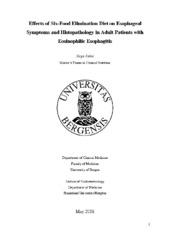| dc.description.abstract | Background and aim: Patients with eosinophilic esophagitis (EoE) usually present with dysphagia and food impaction events. A subgroup of EoE patients do not experience symptomatic improvement despite the use of corticosteroid therapy. The effectiveness of an empiric six-food elimination diet (SFED) has been demonstrated in children and adults suffering from EoE, but this diet has not yet been tested in a Norwegian cohort. We aimed to assess the effects of the SFED on esophageal symptoms and histopathology in Norwegian adult patients with EoE. Subsequently, systematic reintroduction of the eliminated foods was carried out to identify potential dietary triggers of EoE. Methods: A total of 10 adults with EoE underwent upper endoscopies with esophageal biopsies, blood tests, skin-prick tests for dietary allergens and aeroallergens, impedance manometry and ambulatory pH-monitoring. After following the SFED for a minimum of six weeks, the following procedures were repeated on each patient: endoscopy with biopsies, blood test, and impedance manometry. Symptomatic responders, defined by decreased frequency of dysphagia episodes from baseline to post-SFED, underwent sequential reintroduction of each eliminated food at 14-day intervals. Symptom scores and health-related quality of life (HRQOL) before and after the SFED were assessed by the Eosinophilic Esophagitis Activity Index (EEsAI) and 36-Item Short Form Survey (SF-36), respectively. Results: The median peak eosinophil count in esophageal biopsies decreased from 80 eos/HPF before to 10.5 eos/HPF after the SFED (p=0.0078). Overall symptom score measured by the EEsAI did not change significantly from baseline (mean 44.9) to after the SFED (mean 30.7). When assessed through patient consultations and change in dysphagia frequency from baseline to after the SFED, seven patients reported improvement in esophageal symptoms. The most common trigger food identified during reintroduction was wheat, and SPT did not effectively predict trigger foods. Notable changes in esophageal peristalsis were not evident, as assessed by impedance manometry. There was no significant change in HRQOL before and after the SFED, as measured by the SF-36. Conclusion: The SFED effectively reduced histopathological signs and improved esophageal symptoms of EoE in adult patients. Sequential reintroduction identified trigger foods, corroborating the role of dietary allergens in EoE pathogenesis. The empiric SFED represents an important alternative treatment modality to corticosteroids in adults, although further research is warranted on its long-term effects on EoE disease activity. | en_US |
